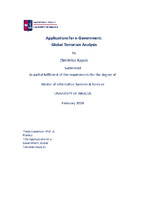| dc.contributor.advisor | Prentza, Andriana | |
| dc.contributor.advisor | Πρέντζα, Ανδριάνα | |
| dc.contributor.author | Kapsis, Dimitrios | |
| dc.contributor.author | Καψής, Δημήτριος | |
| dc.date.accessioned | 2024-04-03T07:43:02Z | |
| dc.date.available | 2024-04-03T07:43:02Z | |
| dc.date.issued | 2024-02 | |
| dc.identifier.uri | https://dione.lib.unipi.gr/xmlui/handle/unipi/16344 | |
| dc.identifier.uri | http://dx.doi.org/10.26267/unipi_dione/3766 | |
| dc.description.abstract | Η τρομοκρατία έχει μεγάλη επίπτωση στην κοινωνία τόσο στις ζωές των ανθρώπων όσο και στην οικονομία. Πολλές καταστροφικές τρομοκρατικές επιθέσεις έχουν συμβεί παγκοσμίως ανά τα χρόνια, προκαλώντας εκτεταμένες υλικές ζημιές αλλά και την απώλεια ανθρώπινων ζωών. Η Τεχνητή Νοημοσύνη έχει αποδειχθεί ένα πολύ πρακτικό εργαλείο για την αντιμετώπιση αυτού του κινδύνου. Σε αυτήν τη διατριβή μελετώνται δύο βάσεις δεδομένων, το “Global Terrorism Dataset” (GTD), και ένα δεύτερο σύνολο δεδομένων QFactors_Dataset, βασισμένο στο GTD, που περιλαμβάνει και ορισμένα επιπλέον χαρακτηριστικά διαφορετικής φύσης, όπως ο αριθμός των προσφύγων και μεταναστών, η μέση διάρκεια ζωής, το επίπεδο εκπαίδευσης κ.ά. Πάνω σε αυτά, δημιουργούνται και συγκρίνονται διάφορα μοντέλα Βαθιών Νευρωνικών Δικτύων (DNN) για να κατηγοριοποιήσουν τις τρομοκρατικές επιθέσεις, βάση της πολιτικής ταυτότητας που έχουν οι τρομοκρατικές ομάδες. Με αυτόν τον τρόπο εξετάζονται διάφορα χαρακτηριστικά που μπορεί να επηρεάζουν την πρόβλεψη του μοντέλου. Αρχικά, πραγματοποιείται καθαρισμός δεδομένων, και ακολουθεί η προ επεξεργασία τους για να γίνουν κατάλληλα για την εκπαίδευση των μοντέλων. Συγκεκριμένα, ήταν απαραίτητο να μετατραπούν τα λεκτικά δεδομένα (περιοχές, χώρες, τρομοκρατικές ομάδες κλπ.) σε αριθμητικά, καθώς και η κανονικοποίησή τους για να μπορέσουμε έπειτα να χρησιμοποιηθούν στα μοντέλα. Η συλλογή δεδομένων αποτελείται από εγγραφές τόσο για επιτυχημένες όσο και για αποτυχημένες επιθέσεις με χρήση διαφόρων όπλων, μεθόδων επίθεσης και στόχων. Τα μοντέλα λαμβάνουν υπόψιν διάφορους παράγοντες, συμπεριλαμβανομένων, της ημερομηνία της επίθεσης, τη χώρα, την τρομοκρατική ομάδα, τον αριθμό των θανάτων, τον τύπο της επίθεσης μαζί με τα όπλα που χρησιμοποιήθηκαν. Όλοι αυτοί οι παράγοντες αναλύονται στις επόμενες ενότητες. | el |
| dc.format.extent | 68 | el |
| dc.language.iso | en | el |
| dc.publisher | Πανεπιστήμιο Πειραιώς | el |
| dc.rights | Αναφορά Δημιουργού-Μη Εμπορική Χρήση-Όχι Παράγωγα Έργα 3.0 Ελλάδα | * |
| dc.rights.uri | http://creativecommons.org/licenses/by-nc-nd/3.0/gr/ | * |
| dc.title | Applications for e-Government : global terrorism analysis | el |
| dc.type | Master Thesis | el |
| dc.contributor.department | Σχολή Τεχνολογιών Πληροφορικής και Επικοινωνιών. Τμήμα Ψηφιακών Συστημάτων | el |
| dc.description.abstractEN | Terrorism has a great impact to the society both in the people’s lives and in the economy. Many devastating terrorist attacks have occurred worldwide over the years causing extensive property damage but also leading to the loss of many human lives. Artificial Intelligence (AI) has been a very practical asset to counter this menace. In this master thesis, the Global Terrorism database (GTD) is studied, along with a second dataset QFactors_Dataset based on GTD, which includes additional features of different nature, such as the number of refugees and immigrants, average lifespan, education level, etc. Various Deep Neural Network (DNN) models are created and compared to categorize terrorist attacks based on the political identity of the terrorist groups. First, data cleaning was performed, and data preprocessing methodologies were employed to make the raw data suitable for training. More specifically, it was essential to convert our text data (regions, countries, terrorist groups etc.) to numbers, and normalize the data, in order to be able to use them in our models. The dataset consists of records for both successful and failed attacks with the use of various weapons, attack methods and targets. The models consider various factors, including, but not limited to the date of the attack, the country, the terrorist group, the number of deaths, the type of the attack along with the weapons used. The second dataset had some additional features of different nature, like the number of refugees and immigrants, life expectancy, the education level, and others. All these factors are analysed in later sections. | el |
| dc.contributor.master | Προηγμένα Συστήματα Πληροφορικής | el |
| dc.subject.keyword | Big data | el |
| dc.subject.keyword | Data science | el |
| dc.subject.keyword | Data analysis | el |
| dc.subject.keyword | Machine learning | el |
| dc.subject.keyword | Neural network | el |
| dc.subject.keyword | Deep neural networks | el |
| dc.subject.keyword | Terrorism | el |
| dc.subject.keyword | Terrorist attacks | el |
| dc.subject.keyword | Terrorist groups | el |
| dc.subject.keyword | e-Government | el |
| dc.date.defense | 2024-02-29 | |



